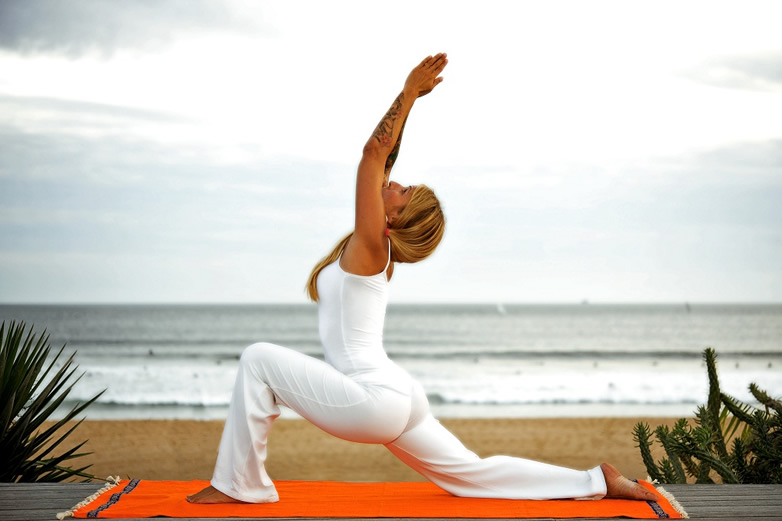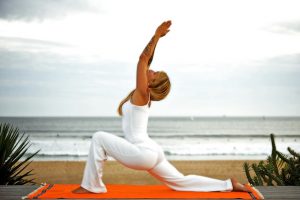One of the biggest hurdles to starting yoga is figuring out what kind you want to do. It’s confusing because there are quite a wide variety of options available. Although almost all of them are based on the same physical postures, each has a particular unique emphasis. This cheat sheet highlights the differences so you can figure out what type is most appealing to you and get started now. To learn more, click through to a full-length article on each style.
Hatha
Hatha is a very general term that can encompass any of the physical kinds of yoga. In contemporary yoga lingo, hatha has come to mean a slow-paced and gentle way of practicing. Hatha class can be a good place to begin a yoga practice because in provides an introduction to the basic yoga poses in a low-key setting.
Vinyasa Flow
Like hatha, vinyasa is a general term that is used to describe many different types of classes. Vinyasa tends to be a more vigorous style based on the performance of a series of poses called sun salutations, in which movement is matched to the breath. A vinyasa class will typically start with a number of sun salutations to warm up the body for more intense stretching that’s done at the end of class. Vinyasa is also called flow, in reference to the continuous movement from one posture the next.
Anusara
Founded in 1997 by John Friend, Anusara combines a strong emphasis on physicalalignment with a positive philosophy based on a belief in the intrinsic goodness of all beings.
Classes are usually light-hearted and accessible, often with a focus on heart opening. As of 2012, Friend is no longer associated with Anusara following nearly a year of turmoil within the yoga system he founded over his personal indiscretions. Anusara is now a teacher-led yoga school and Friend has started a new yoga style called Sridaiva (see below).
Ashtanga
Ashtanga is a fast-paced, intense, flowing style of yoga founded by Pattabhi Jois in the 1960s. A set series of poses is performed, always in the same order. This practice is very physically demanding because of the constant movement from one pose to the next and the emphasis on daily practice. It was one of the first yoga styles embraced by a large number of western students and had been very influential in the evolution of yoga in the past 30 years.
Baptiste Power Vinyasa
Baron Baptiste is a power yoga innovator who studies many different styles of yoga, martial arts, and meditation before coming up with his own unique way of teaching yoga. His style is based on “5 Pillars”: vinyasa, ujjayi pranayama, heat, uddiyana bandha, and drishti. Classes, which are conducted in a heated room, are typically strong and sweaty.
Bikram / Hot Yoga
Hot yoga was pioneered by Bikram Choudhury, whose name became synonymous with yoga classes taught in a room heated to 95 to 100 degrees. The heat allows for the loosening of tight muscles and profuse sweating, which is thought to be cleansing. The Bikram method is a set series of 26 poses, but not all hot classes make use of this series.
CorePower Yoga
This chain of hot yoga studios was founded in Denver in 2002 and is rapidly expanding throughout the United States.
Expect consistent instruction in an upscale gym-like setting. A membership is good at any of their studios nationwide.
Iyengar
Based on the teachings of the yoga master B.K.S Iyengar, this style of practice is all about bringing the body into its best possible alignment, often using props such as yoga blankets, blocks, and straps to assist students as necessary. Iyengar practice usually emphasizes holding poses over longer periods of time instead of moving quickly from one pose to the next (as in a flow class). Iyengar has been very important in the development of modern yoga asana.
Jivamukti
This style of yoga emerged in the 1980s from one of New York City’s best-known yoga studios.
Jivamukti founders David Life and Sharon Gannon were influenced by the rigor of Ashtanga yoga (see above), in combination with chanting, meditation, and spiritual teachings. They have trained many teachers who have brought this style of yoga to studios and gyms, predominantly in the U.S. and Europe. Jivamukti classes are physically intense and often include an inspirational theme selected by the teacher.
Mueller 255 Lumbar Support Back Brace with Removable Pad, Black, Regular(28″ – 50″ waist)

Forrest
Headquartered in Santa Monica, California, and gaining popularity around the U.S., Forrest Yoga is the method taught by Ana Forrest. The performance of vigorous asana sequences is intended to strengthen and purify the body and release pent-up emotions and pain to encourage healing of physical and emotional wounds. Expect an intense workout with an emphasis on abdominal strengthening, inversions, and deep breathing.
Kripalu
Kripalu is both a yoga style and a retreat center in Stockbridge, Massachusetts. Kripalu is a yoga practice with a compassionate approach and emphasis on meditation, physical healing, and spiritual transformation that overflows into daily life. It also focuses on looking inward and moving at your own pace, making it a good practice for people with limited mobility due to age, weight, illness, or injury.
Kundalini
The emphasis in Kundalini is on the breath in conjunction with physical movement, with the purpose of freeing energy in the lower body and allowing it to move upwards through all the chakras. All asana practices make use of controlling the breath, but in Kundalini the exploration of the effects of the breath (also called prana, meaning energy) on the postures is essential. Kundalini exercises are also called kriyas.
Integral
Integral is a gentle hatha style of yoga based on the ideas and principals of Sri Swami Satchidananda, who sought to give followers guidelines on how to improve their lives. In an attempt to integrate mind, body, and spirit, classes also include pranayama, chanting, and meditation.
Moksha/Modo
Moksha hot yoga was founded in Canada in 2004. In 2013, they changed the name of their affiliated U.S. studios to Modo Yoga. Both styles are based on a series of 45 poses done in a heated room. The studios are expected to adhere to environmentally conscious building and cleaning standards and to foster a sense of community for their students.
Power Yoga
In the mid-1990s, several prominent teachers who were well-trained in traditional yoga were looking for ways to make flow yoga more accessible to more people. The resulting classes came to be known by the umbrella term of power yoga. Power yoga was initially heavily influenced by the intensity of Ashtanga but allowed for variation in the sequencing of poses at the discretion of the teacher. Contemporary power yoga classes are essentially vigorous vinyasa flow.
Restorative
Restorative yoga makes use of props to support the body as it relaxes into poses over the course of several minutes. The idea is to stay in each pose long enough to encourage passive stretching. Seated forward bends, gentle supine backbends, and twists are examples of the type of poses that can be adapted to be restorative with the addition of props like blankets and bolsters.
Sivananda
The first Sivananda Yoga Vedanta Center was founded in 1959 by Swami Vishnu-devananda, a disciple of Swami Sivananda. There are now close to 80 locations worldwide, including several ashrams. Sivananda yoga is based on five principles, including the practices of asana, pranayama, and meditation. The mastery of twelve carefully selected poses is at the core of this practice
Sridaiva/Bowspring
After leaving Anusara Yoga (see above) in 2012, John Friend started Sridaiva with Colorado studio owner Desi Springer. This style introduces a new alignment system, which they call the bowspring. It’s pretty different from other types of yoga in that the knees stay bent in many poses and the pelvis is always tipping forward to maintain the spinal curves. Proponents say they find a new source of strength and power from this alignment.
Viniyoga
Viniyoga is the term used by T.K.V. Desikachar to describe the methodology that his father, revered teacher T. Krishnamacharya, developed late in his life. It is based on an individualized approach to each student, creating a practice that suits his or her unique stage of life and state of health. Even in group classes, Viniyoga is adapted to fit each person’s particular needs.
Yin Yoga
Yin Yoga is a practice developed by teacher Paul Grilley to stretch the body’s connective tissue, particularly around the joints. In order to do this, specific poses are helping over the course of several minutes. Grilley intended this practice to prepare the body to be able to sit in long meditation sessions and to act as a counterpoint to movement-oriented vigorous yang styles of yoga.
Still not sure which yoga style is right for you? Take this quiz and find out what your yoga personality is!


